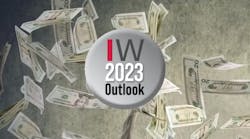November’s Institute for Supply Management Purchasing Manager’s Index brought an end to two and a half years of “official” growth in the manufacturing sector when it dipped just below 50% thanks in large part to drops in new orders and hiring.
It’s clear the economy is slowing and any recession that might arrive will be among history’s most anticipated. But heading into 2023, it should also be said that the sky isn’t falling: The ISM’s production index is still firmly in expansionary territory, many companies have said recently they still have bumper backlogs and there are several tailwinds sustaining investment in and demand for industrial products. As Bank of America Institute economists David Tinsley and Anna Zhou wrote last week, 2023 is lining up to be a balance between some conventional cyclical softening and reasons to remain optimistic for the longer term.
“While the post-pandemic surge in manufacturing will struggle to be maintained, there are still some reasons for cheer as we enter 2023,” they wrote. “We think the impending boosts from [pent-up demand for] autos and reshoring are enough to warrant a healthy dose of optimism.”
Among the reasons to be upbeat, former Federal Reserve and White House economist Claudia Sahm wrote last week, is that inflation is broadly ebbing—a stance backed up by Tuesday’s lower-than-expected November Consumer Price Index report. Encouraging data on gas prices, loosening supply chains, consumers’ price expectations and wage data, Sahm said, are tilting the scales.
“The inflation hawks must tell us why their story remains so dire after the data during the past two weeks,” Sahm, founder of Stay-at-Home Macro Consulting, wrote. “And remember: Good news is good news. The past two weeks have been good.”
An IndustryWeek survey of manufacturing executives conducted from late November into early this month echoes several of the more upbeat demand data points out there—but also provides food for thought on the inflation front.
First, to the rosier and relatively clearer picture of demand: Of the slightly more than 100 executives who responded to our prompts, 58 are expecting 2023 to be somewhat or substantially better than this year while only 22 said their businesses will take a step back. Similarly, 47 are confident enough to want to add to their workforces while just four said they plan to lay off some employees.
On a related labor note, those saying the availability of workers is (somehow still?) getting worse outnumbered those saying that supply is improving by a 3:2 margin. But both of those camps combined were less numerous than executives saying the tight labor market will get neither better nor worse.
Not surprisingly, that slightly negative take on labor is broadly reflected in respondents’ 2023 compensation outlooks. While nearly 40% of those surveyed said they are looking to hold the line on salaries and benefits in the coming year, nearly as many said they will boost either their pay or benefit levels and 24% said they’ll invest more in both key elements of their teams’ compensation.
That’s a collective mindset that could sustain wage growth near its current 5% level, even as headline inflation numbers retreat below that mark. (That’s already the case on a rolling three-month cycle but a while away for the 12-month CPI number.) Combined with ongoing inflation fears—nearly half of our respondents said the expectation of rising prices is among their top three concerns for the coming year—rising personnel costs could keep today’s above-average inflation higher for longer since they typically retreat far more slowly than they rise.
Executives’ plans to continue to raise prices after several years of rising input costs (and maybe also ahead off the still-higher prices they expect to pay) also looks set to contribute: Nearly 70 respondents said they plan to raise their prices “slightly”—admittedly, that’s a phrase open to some interpretation—while nine said they have “substantial” price hikes in the works and just four said they will lower prices in 2023. And that’s with November’s Producer Price Index still clocking in at 7.4%.
More than 50 of the leaders who responded to our poll said their confidence in their ability to hike prices was one of their top three reasons for ’23 optimism. (By contrast, 37 leaders said not being able to pass along costs ranked highly on their list of concerns.) That confidence raises the specter of finished-goods prices climbing for a sustained part of 2023, well after the bill for many raw materials as well as freight services and other input costs began noticeably falling this summer and fall.
Tinged by worries
A recent Nationwide survey of small- and mid-sized business owners as well as insurance agents also produced a combination of overall confidence tinged by inflation worries: More than seven of 10 small-business owners and 85% of mid-market firm leaders said their companies are “heading in the right direction” going into 2023. Similarly, 77% of the middle-market business leaders surveyed said they plan to hire more people next year.
Here's the inflation “but,” though: About two-thirds of both groups of business owners said they expect inflation to have a greater impact on their efforts in 2023 than it has this year. And inflation ranks highest among both groups’ concerns about their outlooks, with no other factor coming within 10 percentage points.
Another report speaking more specifically to concerns about wage inflation was recently published by the Poole College of Management at North Carolina State University and consulting firm Protiviti. The survey of about 1,300 C-suite executives and board members from around the world showed that the risk of rising labor costs hurting firms’ ability to hit profitability targets has risen to third on the list, up from sixth a year ago. (A related first: The ability to attract and retain talent.)
“With companies struggling to fill open positions and inflation running hot, this issue has the potential to be stubbornly persistent,” the report’s authors wrote, later pointing out that rising labor costs rank as the No. 2 risk among companies with less than $100 million in sales.
Among the manufacturing and distribution leaders who responded to the NC State/Protiviti poll, supply chain uncertainty was the most acute concern for the second year in a row, although sentiment has improved slightly from 12 months ago. Labor costs ranked third among worries, slightly behind overall economic conditions, but showed the largest year-over-year increase among the most prominent concerns.
A few other findings from our own poll:
- Just how confusing is the supply chain situation? Nearly three years after the COVID virus began to spread and disrupt trade flows, an equal number of respondents (58) put the evolving state of their supply chains as both a reason to be upbeat about 2023 or as one of their top three concerns.
- The Inflation Reduction Act, many parts of which officially come into effect Jan. 1, is expected to be a nice tailwind: Nearly a third of our respondents picked it as one of their three top reasons to be optimistic about the 12 months ahead.




